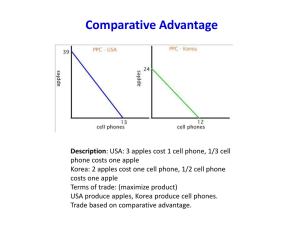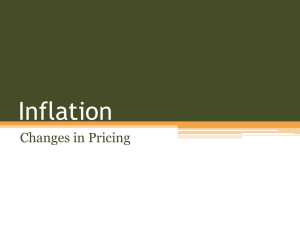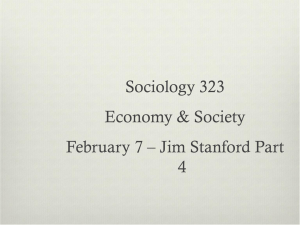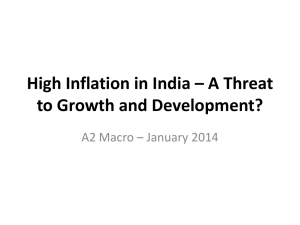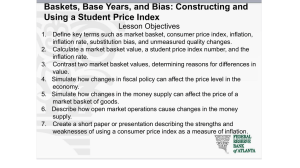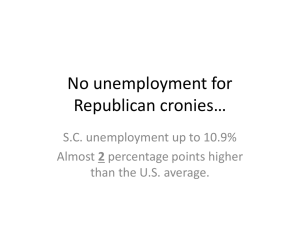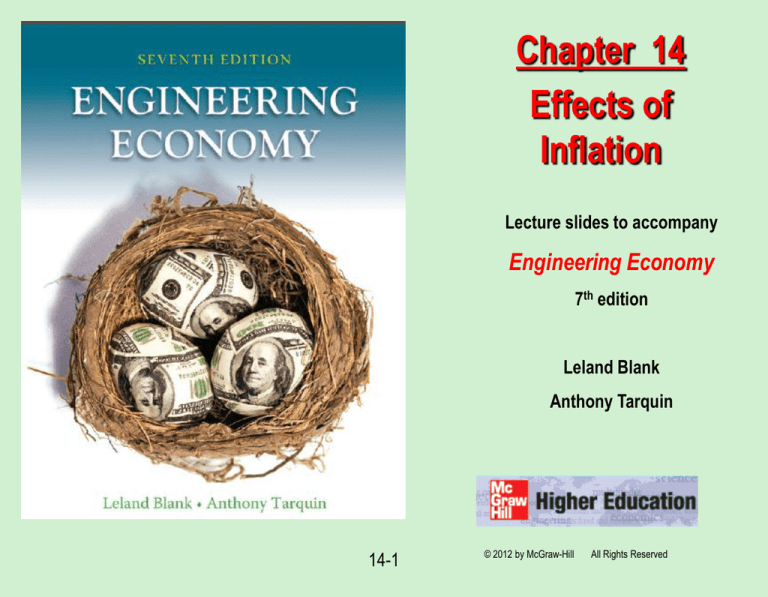
Chapter 14
Effects of
Inflation
Lecture slides to accompany
Engineering Economy
7th edition
Leland Blank
Anthony Tarquin
14-1
© 2012 by McGraw-Hill
All Rights Reserved
LEARNING OUTCOMES
1. Understand inflation/deflation
2. Calculate PW of cash flows with
inflation
3. Calculate FW with inflation considered
4. Calculate AW with inflation considered
14-2
© 2012 by McGraw-Hill
All Rights Reserved
Understanding Inflation
Inflation: Increase in amount of money needed to purchase same amount
of goods and services
Caused by decrease in purchasing power of currency
Two ways to work problems when considering inflation:
(1) Convert dollars into cv dollars, then use real rate, i (i.e. the rate used heretofore)
Can create constant-value dollars with following equation:
Constant-value dollars = future dollars
(1+ f)n
(2) Leave dollar amounts as is and use interest rate adjusted for inflation, if
where, if = i + f + (i)(f)
Deflation: Purchasing power of money is greater in future than at present
14-3
© 2012 by McGraw-Hill
All Rights Reserved
Example - Constant Value Dollars
How many dollars would be required today to purchase an item that increased in
cost by exactly the inflation rate if the cost 30 years ago was $1000 and inflation
was 4% per year?
Solution::
Future dollars = constant value dollars(1 + f)n
= 1000(1 + 0.04)30
= $3243
Note: This calculation only accounts for the decreased purchasing power
of the currency. It does not take into account the time value of money,
which will be discussed next.
14-4
© 2012 by McGraw-Hill
All Rights Reserved
PW Calculations with Inflation
Two ways to account for inflation in PW calculations:
(1) Convert cash flow into constant-value dollars (CVD) and use regular i
Where: CVD = then-current dollars/(1 + f)n
f = inflation rate
(Note: Calculations up to now have assumed constant-value dollars)
(2) Express cash flow in then-current dollars and use inflated interest rate
Where: if = i + f + (i)(f)
( Note: the inflated interest rate is the market interest rate)
14-5
© 2012 by McGraw-Hill
All Rights Reserved
Example PW with Inflation
A certain machine will have a cost of $25,000 (then $) six years from now.
Find the PW of the machine if the real interest rate is 10% per year and
the inflation rate is 5% per year using (a) constant-value dollars, and
(b) then-current dollars.
Solution:
(a ) First find constant-value dollars and then use i in equations:
CVD = 25,000 / (1 + 0.05)6 = $18,655
PW = 18,655(P/F,10%,6)
= $10,531
(b) Leave dollars as then-current and use if in equations:
if = 0.10 + 0.05 + (0.10)(0.05) = 15.5%
PW = 25,000(P/F,15.5%,6)
= $10,530
14-6
© 2012 by McGraw-Hill
All Rights Reserved
FW Calculations with Inflation
FW values can have four different interpretations:
(1) The actual amount of money accumulated
(use if in FW equations)
(2) The purchasing power (in terms of today’s dollars) of the future amount
(use if in FW equations and divide by (1+f)n or use real i)
where real i = (if – f)/(1 + f)
(3) The number of then-current dollars required to have the same purchasing
power as a dollar today (no time-value considered)
(use f instead of i in F/P factor)
(4) the amount required to maintain the purchasing power of the present
sum and earn a stated rate of return (i.e. a real interest rate)
(use real i in FW equations)
14-7
© 2012 by McGraw-Hill
All Rights Reserved
Example FW with Inflation
An engineer invests $15,000 in a savings account that pays interest at a
real 8% per year. If the inflation rate is 5% per year, determine (a) the amount
of money that will be accumulated in 10 years, (b) the purchasing power of
the accumulated amount (in terms of today’s dollars), (c) the number of
then-current dollars that would have the same purchasing power as the
$15,000 today, and (d) the amount to maintain purchasing power and earn a
real 8% per year return.
Solution:
(a) The amount accumulated is a function of the market interest rate, if
if = 0.08 + 0.05 + (0.08)(0.05) = 13.4%
Amount Accumulated = 15,000(F/P,13.4%,10)
= $52,750
14-8
© 2012 by McGraw-Hill
All Rights Reserved
FW Example Cont’d
(b) To get the purchasing power of the accumulated amount, must deflate
the inflated dollars
Purchasing power = 15,000(F/P,13.4%,10) / (1 + 0.05)10
= $32,384
(c) The number of then-current dollars that would be required to purchase
goods that cost $15,000 now would be the inflated cost of the goods
Number of then-current dollars = 15,000(F/P,5%,10)
= $24,434
(d) In order to maintain purchasing power and earn a real return, money must
grow by the inflation rate and the interest rate, or if [13.4% as in part (a)]
FW = 15,000(F/P,13.4%,10)
= $52,750
14-9
© 2012 by McGraw-Hill
All Rights Reserved
CR Calculations with Inflation
The A/P and A/F factors require the use of if when inflation is considered
If a small company invests $150,000 in a new production-line machine,
how much must it receive each year to recover the investment in 5
years if the real interest rate is 10% and the inflation rate is 4% per year?
Solution:
if = 0.10 + 0.04 + (0.10)(0.04) = 14.4%
A = 150,000(A/P,14.4%,5)
= $44,113
14-10
© 2012 by McGraw-Hill
All Rights Reserved
Summary of Important Points
Inflation occurs because value of currency has changed
Two ways to account for inflation in economic analyses:
(1) Convert all cash flows into constant-value dollars and use i
(2) Leave cash flows as inflated dollars and use if
During deflation, purchasing power of money is greater in future than
at present
Future worth values can have four different interpretations
Use if in calculations involving A/P or A/F (when inflation is
to be considered)
14-11
© 2012 by McGraw-Hill
All Rights Reserved

